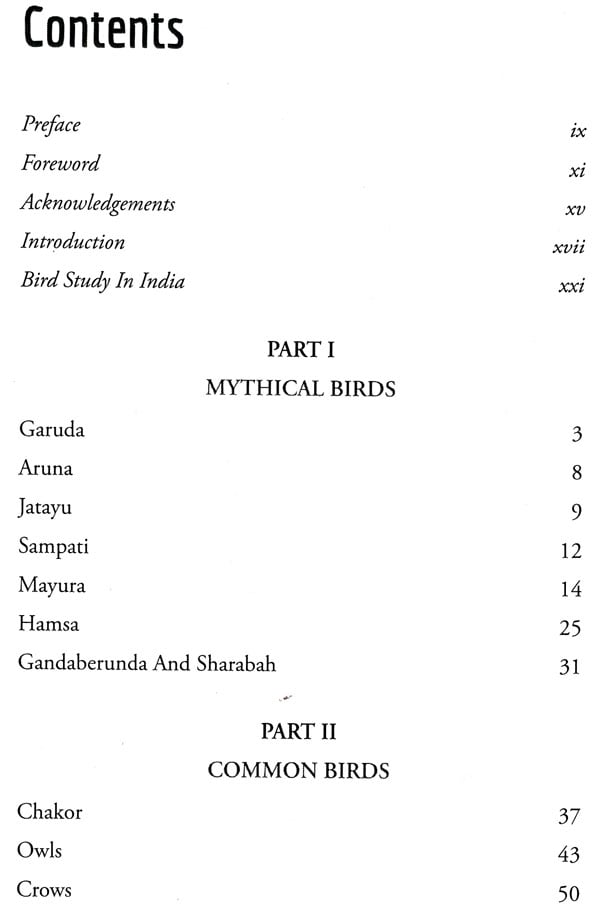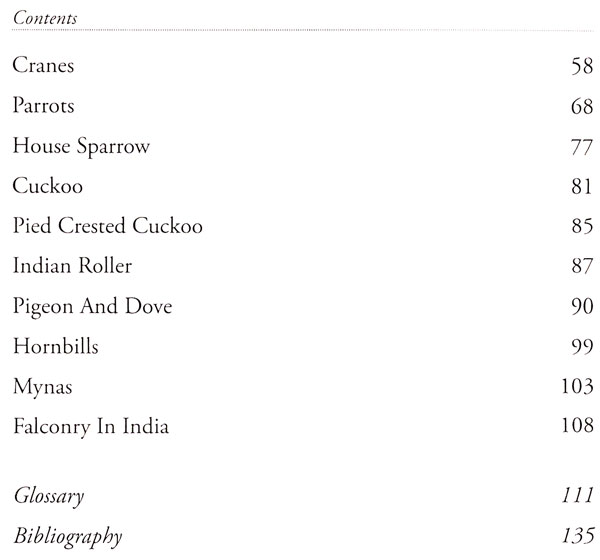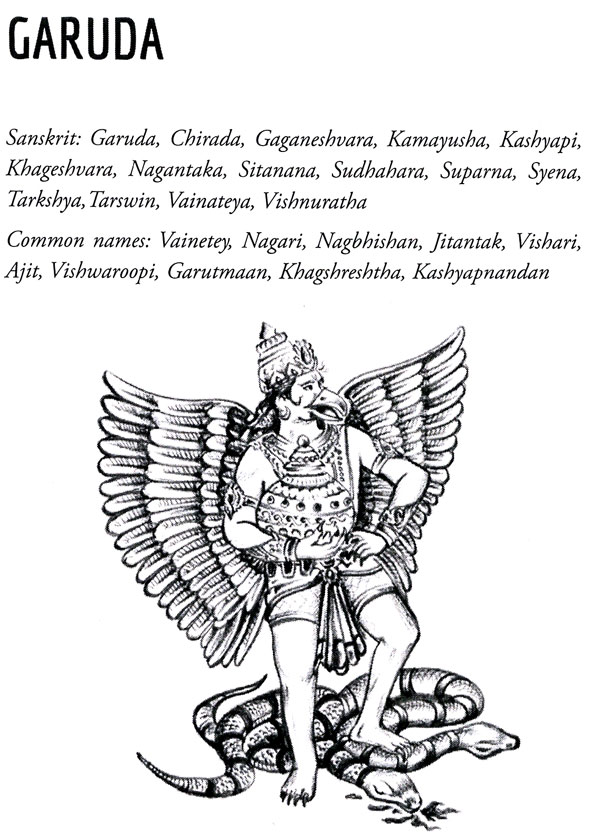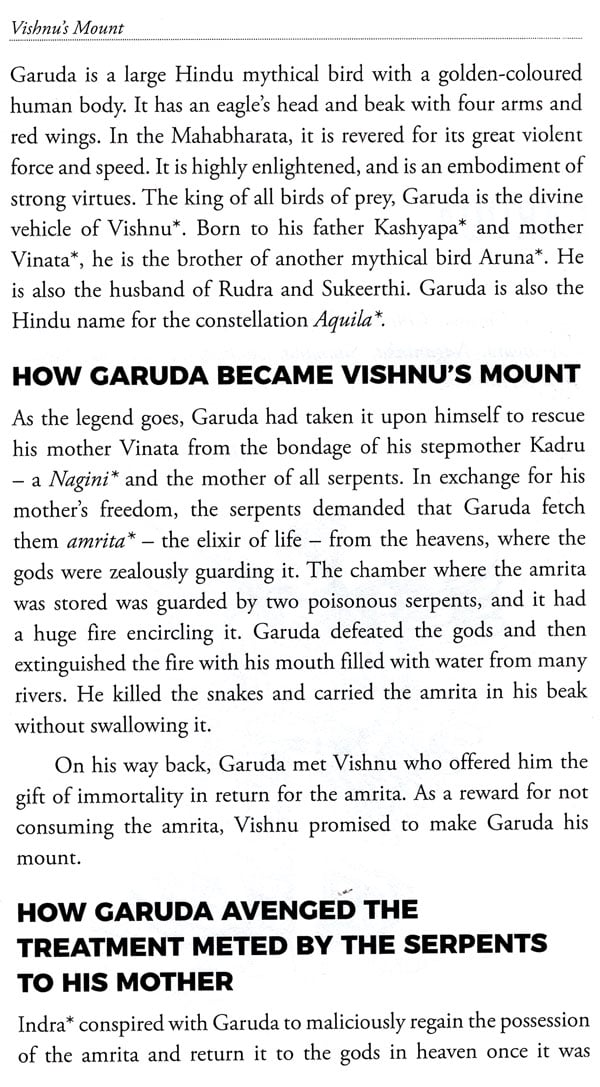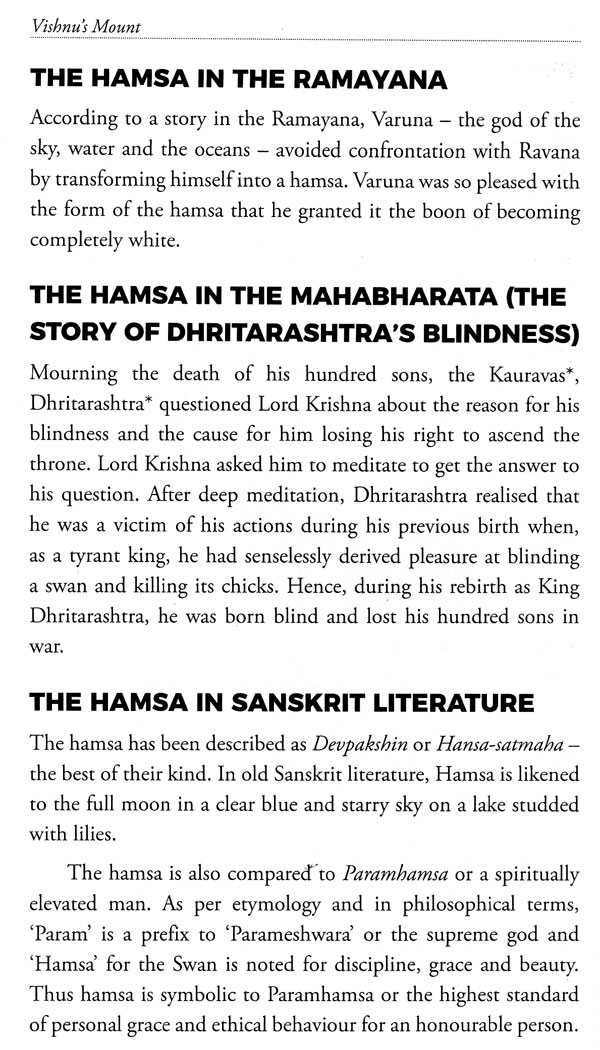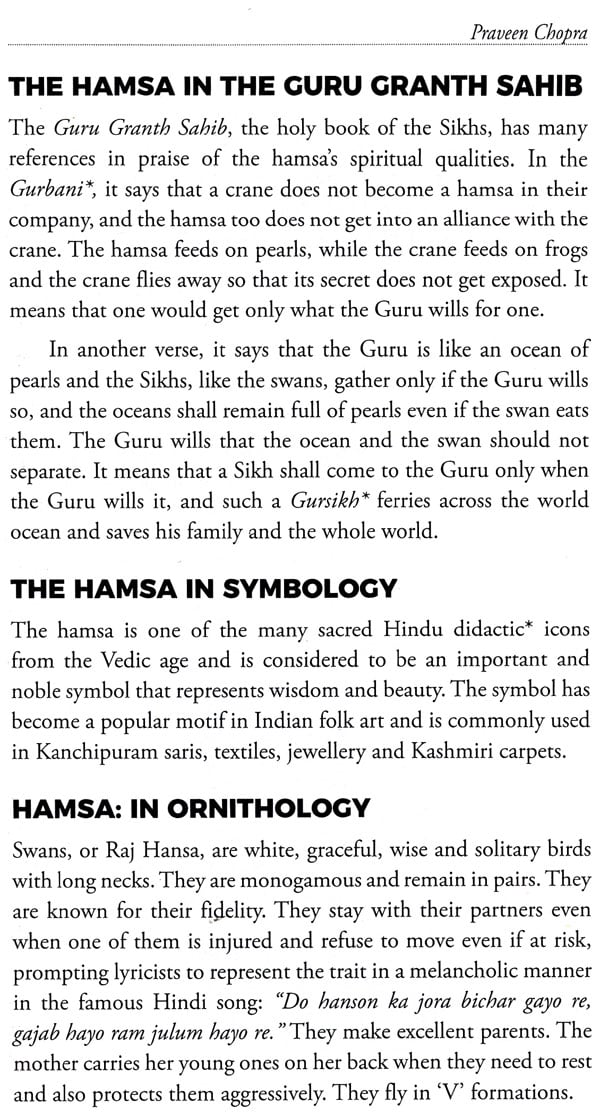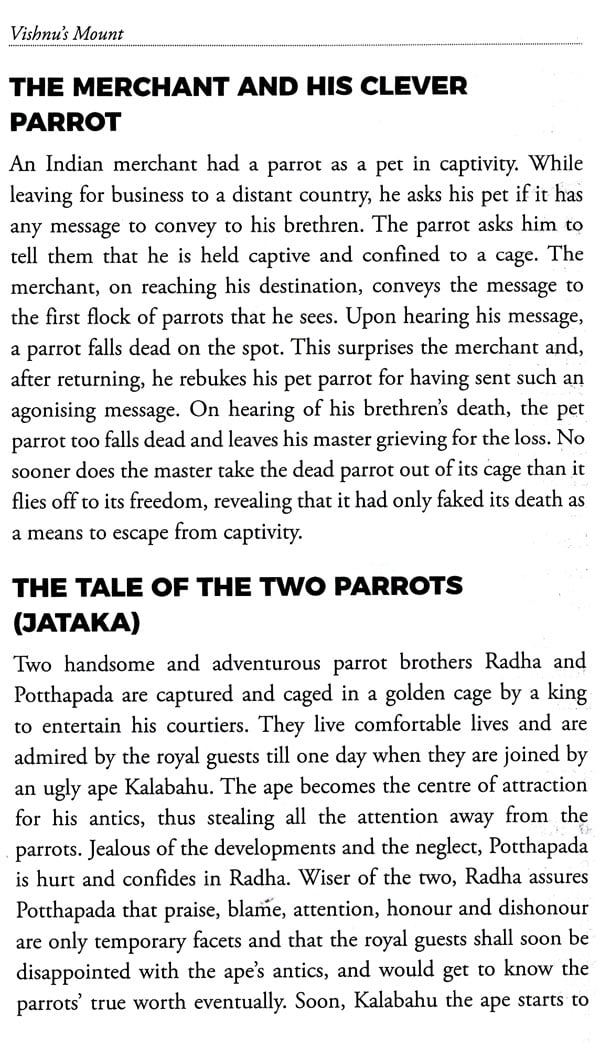
Vishnu's Mount (Birds in India Mythology and Folklore)
Book Specification
| Item Code: | NAQ784 |
| Author: | CAPT. Parveen Chopra |
| Publisher: | Notion Press |
| Language: | English |
| Edition: | 2017 |
| ISBN: | 9781948352680 |
| Pages: | 169 |
| Cover: | HARDCOVER |
| Other Details | 8.50 X 5.50 inch |
| Weight | 290 gm |
Book Description
Praveen Chopra is a naturalist, avid bird-watcher, photographer, conservationist and freelance writer who spends as many mornings as he can spare in open spaces, often trekking and observing birds along the Ganga's marshy banks through which the river has meandered in earlier years. He mourns the shrinking bird population and the thoughtless massacres that they are subjected to by greedy hunters who do not think twice about poisoning the waters on which they alight and in which they frolic. His enthusiasm, however, does not diminish for long. A rare sighting, the glimpse of a breeding pair or a nest that promises future delights him. The fact that some homes in Kanpur, a generally inhospitable city for birds, remain filled with dozens of sparrows are always enough to raise his hopes. Indeed, Praveen is a remarkable person.
Praveen is even more unusual because he looks for birds not only in trees and marshlands but also in books, myths and Indian epics. It is this passion that has inspired this book that he has written and which you, the reader, are about to immerse yourself in. It is a fascinating journey that you will embark upon, on the wings of Lakshmi's owl, Murugan's mayura and Vishnu's garuda amongst others. I have made some forays on this journey, and I can vouch for many magical moments during its course.
Praveen has made a tremendous effort to bring together references to birds in the Puranas, in the Jataka tales and in various versions of Indian epics. He has found parallels between birds that are familiar to all of as and those that have been endowed with magical properties that enable them to perform heroic deeds in mythology. It was a bird that led Hanuman to Sita in the enclosed garden in Ravana's palace; it was a bird that told Rama about Sita's abduction; it was a bird that stole amrita from the gods in order to appease the snakes who were torturing its mother; and, it was the same bird that avenged his mother by killing many of the snakes. There are many, many more wonderful tales and legends that the bird lover in Praveen has laboured for years to uncover and finally compile in a book that is lucid and insightful.
For many people, birds and animals that are the vahanas (mounts or the vehicles) of a host of gods and goddesses in Hindu mythology have themselves become objects of worship and veneration. This is despite the fact that not many attempt to reason why a particular bird or animal has been associated with a particular deity. His book Vishnu's Mount delves into these questions. Praveen relies not only on the explanations that he has painstakingly gleaned from a range of references but also on his own knowledge of ornithology and the habits of birds that he has himself studied and watched so intimately.
The earliest bird watchers and bird lovers in our country were its earliest inhabitants, mostly tribal people belonging to various tribes and clans within tribes. All across the world, tribals and indigenous people have venerated and protected nature - forests, birds and animals - despite the fact that they have been dependent on these for food, clothing, weapons and shelter. Aware of the value of their natural habitat and of its fragility and vulnerability, they hunted and utilised with caution and consideration what the forests and wild plains made available to them in abundance. Most tribes associated themselves with one particular bird or animal - their totem* - which they did not hunt or eat. Perhaps this was a primitive form of conservation.
This veneration of totem birds and animals has continued until the modern period and is well recorded. For example, the Santal (Santhal) tribals living in the Eastern part of the country believe that the two earliest living beings were a heavenly bird couple - Has and Hasil (Goose and Gander) - whom God created from his hair. After flying between heaven and earth for some time, they built a nest and laid eggs. The first male human, Pilchu Haram, and female human, Pilchu Burhi, emerged out of these eggs. In this way, the pair of birds Has and Hasil was credited with the creation of the human race. Many tribal clans were their progeny, and the one with the highest status was the Hansdak clan whose members claim direct descent from Has (wild goose or swan). Dak means water and refers to the nest that their bird ancestors built on the water that covered the earth at the beginning of time.
The clan that is second in importance is the Murmu clan that has the antelope as its totem. The third is the Kisku clan that has the kingfisher as its totem and is of royal status.
All the clans were devoted to their totem animals and birds and thought of them as their clan members. If they found their totem bird (or animal) dead, they observed funeral rituals in their honour.
Over time, the tribals were displaced from their primacy in most parts of the country by agricultural settlers with different gods. The vahanas may be telling us the story of this displacement in ways that have still not been completely understood or accepted, and it is very likely that the'vahanas actually represent the tribes for whom they were the totem. Their becoming the vehicles of various gods and goddesses may be a depiction of the vanquishing of a tribe by the worshippers of a particular deity. At the same time, the fact that the vahanas continue to be venerated or worshipped by the victors maybe a tribute to the bravery of the vanquished tribals and a mark of respect for their beliefs.
Surely, we need to treat these birds and animals with respect, these vahanas that we continue to worship and venerate with the kindness and consideration that our tribal ancestors did and our tribal brothers and sisters continue to do even today. I am sure that Praveen not only empathises with these tribal sentiments but is doing whatever he can to promote them. The devotion with which he has written this book and brought to light so many aspects of our heritage and the important place that birds occupy in our folklore should inspire all of us, his readers, to not only appreciate what he is sharing with us but to respond to the heartfelt plea that is not seen but can be felt on every page of his book to treat birds with both awe and love. The cruelty that is often inflicted on them must inspire horror and opposition.
Readers of this book will certainly enjoy every page of it. I am sure it will inspire many to enter the wonderful and inspirational world of bird-watching, bird-studying and bird-loving. And for that, they will thank Praveen for the rest of their lives.
Over the centuries, man has been deeply fascinated by the ability of his feathered friends to freely soar the skies. He has been inspired by their beauty, power, grace, speed, endurance, intelligence, killing instinct, and above all, their fidelity and infallible spirit. He has held them in awe, and seeing in them the divine and the supernatural, he started relating to them in spiritual and philosophical terms. Birds mystified him and became a part of his folklore, superstitions, allegories, poetry and literature. He domesticated them, spoke to them and even taught them his language. He hunted them and used them for sport and entertainment. Birds became a part of his rituals in both birth and death alike.
In Indian mythology, our seers had the wisdom and insight to understand the character and power of Mother Nature and its impact on mankind. They revered birds and anthropomorphised them. Birds were depicted as the vehicles or mounts of many Indian gods and deities to remind us of the need to overpower our wild instincts and move towards self-realisation. Lord Vishnu rides Ganda, Goddess Saraswati is seated on a swan, Murgan, or Kartikeya, rides a peacock, Lord Shani* rides a crow, Kamadeva, the god of love, is seated on a parrot, Goddess Lakshmi rides an owl and so on.
The divine status that birds enjoy in Indian mythology has also built a string of superstitions around them in Indian folklore. Owls, being the mount of Goddess Lakshmi, are considered a
Good omen by some, while others consider them inauspicious as they believe owls are a manifestation of Alakshmi* - the opposite of Lakshmi. Similarly, crows are believed to be the carriers of food to departed souls, and hence, are fed extensively during the period of 8raddha*, while the Vedic Indians considered them to be inauspicious and evil. The sighting of an Indian Roller -blue jay - on the day of Dussehra is considered auspicious as it is believed to be an incarnation of Lord Shiva, while the peacock has been protected through the ages out of religious sentiments associated with gods such as Lord Krishna.
Birds have enjoyed descriptions in our ancient scriptures and texts: in the Upanishads, Vedas, Puranas*, Shastras* and epics such as the Ramayana and the Mahabharata that date back to many centuries BC. In the Yajur Samhita*, parrots and mynas were taught to talk and were a source of wisdom and sound advice to humans.
Our Vedic seers had made many accurate observations about bird behaviour, the most specific one amongst them being brood parasitism* prevalent in the cuckoos or the koels. They have appended such observations in their Sanskrit scripts and literature. Doves, eagles, cranes and vultures are some of the many birds that find mention in Indian iconography, mythology, folklore and literature.
Birds also figure prominently in the legendary Panchatantra* and Jataka* stories that have been an integral part of Indian folklore for centuries and impart lessons in common wisdom and moral values amongst the younger generation. Importantly, the characteristics that the birds represent in these stories are quite synonymous with the behaviour commonly visible amongst these birds in reality. The influence of birds in Sanskrit and medieval Indian literature is amply visible in Kalidasa's Meghaduta and Abhijnanashakuntala.
The age-old tradition of feeding birds before meals is practised by followers of different religious faiths even today. Many households maintain feeding trays and birdbaths in their courtyards - a practice considered to be a part of one's religious faith. Feeding pigeons, sparrows, crows and parrots at the main traffic hubs in the heart of a metro city is a common sight even today. Newly married couples are asked to visit and pay obeisance to Sarus cranes, which are known for their fidelity.
The peacock was declared as the national bird because of the stature it enjoys in Indian culture and also because it forms a part of many poetic compositions, motifs and traditional textile designs. The enchanting Mayura dance continues to be a part of many cultural performances, and one never tires of marvelling at the dance of the peacock in the wild and when enacted on stage. The Koel and Papiha too have deeply influenced Indian folklore, and have inspired many writers and poets to pen down numerous classic compositions. The call of a koel announces the onset of spring with the season of sumptuous mangoes around the corner. Birds have strongly influenced Indian folklore and are deeply woven into the tapestry of Indian culture.
Dual interests in both mythology and birds often sent me scurrying to pundits who could enlighten me on the two diverse subjects with equal dexterity. Long marathon sessions with friends and masters would leave me wondering about the deep influence that birds have on civilisations and cultures across the world, and more so in the Indian context.
Birds are a common part of Indian folklore, music and literature and are frequently anthropomorphised* and linked to deities as their mounts in Indian mythology. Our seers projected them in a supernatural manner, probably with a sense to convey a deep philosophical message about them. There is a missing link between how our seers saw birds during their times and how we see them today in scientific, economic and ecological terms. These two perceptions have been bridged and presented in today's context for better understanding.
For a generalist, the subject was too serious to be delved into and had to be simplified for easy assimilation. As I went fishing for more content, I realised that it was too scattered for my comfort and I felt the need to compile the available knowledge and piece it together under one cover. The resultant effort is not purported to be a research paper. It must, instead, be seen as an effort to discover the wonderful world of mythology and birds in a combined and holistic manner.
